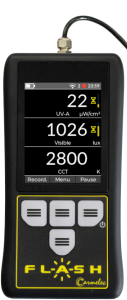Various NDT methods
Non-destructive testing (NDT) certainly began with the need to know whether components meet quality requirements and specifications. Carmelec focuses on two major NDT fields: Magnetic Particle Inspection and Penetrant Testing..
Surface Inspection Methods
Both Magnetic Particle Inspection and Penetrant Testing are so-called surface methods because they make it possible to detect discontinuities on or very close to the surface.
Magnetic Particle Inspection and Penetrant Testing
Our measurement devices, Analysse II and Intensis , measure the intensity of the magnetic fields used for detecting surface-breaking discontinuities. Our Magnetis II is designed to assess the demagnetization of parts after verification.
Our Flash device (radiometer/light/ meter/color temperature meter) measures visible light and/or UV-A radiation and/or the color temperature on the surface of the parts to be inspected.
Magnetic Particle Inspection
Magnetic Particle Inspection applies only to ferromagnetic parts. It only detects surface-breaking or shallow sub-surface (approx. 1 mm) discontinuities, such as cracks or quenching cracks. Painted parts can be inspected provided the paint layer is less than 50 µm.
This method is sensitive to the orientation of discontinuities on the surface. Thus, detecting a crack in the longitudinal or transverse direction does not exactly require the same technique.
Magnetic Particle Inspection works as follows: the area to be inspected is magnetized, causing the magnetized field to leak into a discontinuity. This causes ferromagnetic particles to be attracted to a discontinuity and form what is known as an indication.
Various types of material are available in the field. Some are portable and can enable on-site testing. Magnetization is usually achieved by passing a current through the part to be inspected, inducing a magnetic field. Alternatively, the area of the part to be inspected can be placed in a magnetic field.
The surface to be inspected is then sprayed or dusted with colored or fluorescent ferromagnetic particles which will stick to the discontinuities.
Finally, the part is observed under suitable lighting, either visible or UV-A, to detect any indications, which will appear as lines or spots.
At the end of the test, it may be necessary to demagnetize the part, otherwise subsequent machining steps could be disturbed, or the part could malfunction during use.
Indications are assessed according to acceptance criteria. Should they exceed the authorized limits, we use the term “defect” and the part is declared non-conforming.
Penetrant Testing
This method is suitable for a wide variety of materials, provided that they are not too porous. It requires the surface to be tested to be free of paint, grease or coatings that could interfere with the penetrant testing process. Only surface-breaking discontinuities will be revealed by this method.
Penetrating testing involves penetrating a product into discontinuities and allowing it to emerge. The indication that emerges is observed and compared with the requirements of the controlled part’s specifications.
There are several processes for ensuring that the penetrant (the product that penetrates discontinuities) comes into contact with the surface of the part. These include immersion, spraying and brushing. The product must be given suficient time to penetrate any surface-breaking discontinuities by capillarity action.
After this action time, which is defined by reference documents, an operation is carried out to remove excess penetrant from the surface, without removing any from discontinuities. Here again, different processes can be applied for removal, such as water rinsing or solvent cleaning.
Then, a developer, generally composed of fine particles, is applied both to facilitate the removal of the penetrant remaining in the discontinuities and provide a good contrast between the color of the penetrant (colored or fluorescent) and the surface of the part.




